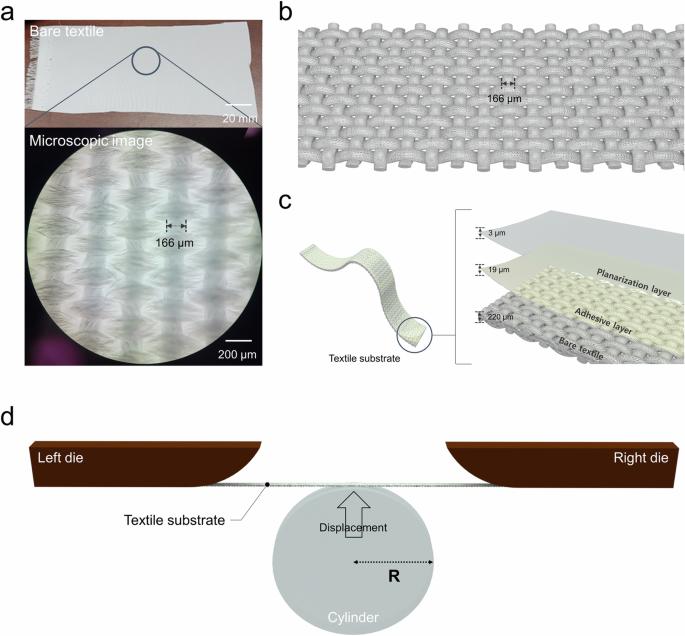Analytic modeling and validation of strain in textile-based OLEDs for advanced textile display technologies
IF 12.3
1区 材料科学
Q1 ENGINEERING, ELECTRICAL & ELECTRONIC
引用次数: 0
Abstract
In the IoT era, the demand for wearable displays is rapidly growing, catalyzing the advancement of research into textile-based organic light-emitting diodes (OLEDs). This growing interest stems particularly from the inherent flexibility of textile-based OLEDs1,2, allowing for seamless integration into the dynamic and interactive functionalities of cutting-edge wearable technology, alongside their superior electrical performance. The durability and mechanical robustness of these displays, especially under physical stress and deformation, are critical to their practical application and longevity. Thus, understanding and enhancing the mechanical properties of textile-based OLEDs is paramount for their successful integration into wearable technologies. However, many studies assessing the mechanical properties of OLEDs have predominantly relied on simplistic bending test outcomes determined by the radius, often neglecting or insufficiently analyzing the strain exerted on the OLEDs atop textile substrates in relation to curvature of these devices. Existing analyses typically presume pure bending, though such an assumption leads to considerable errors in strain estimations, making such approaches problematic if the goal is practical application in actual wearable display products. To address these limitations, an analytic model that includes a comprehensive energy equation is introduced, considering the stretching energy, bending energy, and shear energy of each layer composing the textile substrate. This holistic approach provides a novel formula specifically designed to calculate the top surface strain of textile substrates. Robust validation of this formula is conducted by comparing its results with strain measurements obtained from digital image correlation (DIC) and finite element analysis (FEA) outcomes from ANSYS across various bending radii (or equivalently, curvatures). The close alignment of the calculated strain values with those derived from DIC and FEA not only underscores the precision of this formula but also highlights its significant potential for enhancing the designs and functionalities of future wearable display technologies under real-world conditions.


先进纺织品显示技术中基于纺织品的有机发光二极管应变的分析建模和验证
在物联网时代,对可穿戴显示器的需求迅速增长,促进了对基于纺织品的有机发光二极管(OLED)的研究。这种日益增长的兴趣主要源于基于纺织品的有机发光二极管固有的灵活性1,2,这种灵活性使其能够无缝集成到尖端可穿戴技术的动态和交互功能中,同时还具有卓越的电气性能。这些显示器的耐用性和机械坚固性,尤其是在物理应力和变形条件下的耐用性和机械坚固性,对其实际应用和使用寿命至关重要。因此,了解并增强基于纺织品的有机发光二极管的机械性能,对于将其成功集成到可穿戴技术中至关重要。然而,许多评估 OLED 机械性能的研究主要依赖于由半径确定的简单弯曲测试结果,往往忽视或未充分分析纺织基底上的 OLED 所受的应变与这些设备的曲率之间的关系。现有的分析通常假定是纯弯曲,但这种假定会导致应变估计出现相当大的误差,如果目标是实际应用于实际的可穿戴显示产品,那么这种方法就会出现问题。为了解决这些局限性,我们引入了一个包含综合能量方程的分析模型,其中考虑了组成纺织品基底的每一层的拉伸能、弯曲能和剪切能。这种综合方法提供了一种专门用于计算纺织品基底表面应变的新公式。通过将计算结果与数字图像相关性(DIC)和 ANSYS 的有限元分析(FEA)结果中不同弯曲半径(或等同于曲率)的应变测量值进行比较,对该公式进行了可靠的验证。计算出的应变值与数字图像相关性和有限元分析得出的应变值非常接近,这不仅强调了该公式的精确性,还突出了其在实际条件下增强未来可穿戴显示技术的设计和功能的巨大潜力。
本文章由计算机程序翻译,如有差异,请以英文原文为准。
求助全文
约1分钟内获得全文
求助全文
来源期刊

npj Flexible Electronics
Multiple-
CiteScore
17.10
自引率
4.80%
发文量
91
审稿时长
6 weeks
期刊介绍:
npj Flexible Electronics is an online-only and open access journal, which publishes high-quality papers related to flexible electronic systems, including plastic electronics and emerging materials, new device design and fabrication technologies, and applications.
 求助内容:
求助内容: 应助结果提醒方式:
应助结果提醒方式:


